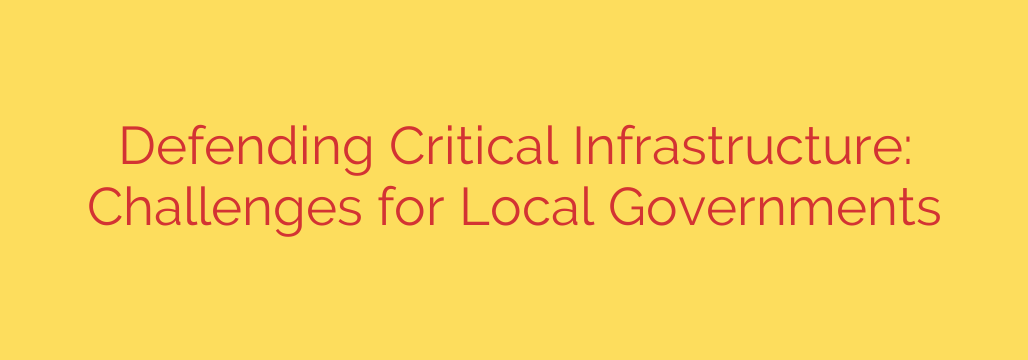
Protecting Our Communities: The Urgent Need for Critical Infrastructure Security at the Local Level
Every single day, we rely on a complex network of services that function silently in the background. We turn on the tap and expect clean water. We flip a switch and the lights come on. We trust that traffic signals will manage the flow of vehicles and that emergency services are just a phone call away. These functions are the bedrock of modern society, and they all depend on our nation’s critical infrastructure.
For local governments, protecting this infrastructure is no longer just a matter of physical maintenance—it has become a frontline in the battle for cybersecurity. From small towns to large metropolitan areas, the systems that manage water treatment, power grids, transportation, and public safety are increasingly in the crosshairs of sophisticated cyber threats. An attack on these systems isn’t just an IT problem; it’s a direct threat to public health and safety.
The Evolving Threat Landscape for Municipalities
Cybercriminals and state-sponsored actors are increasingly targeting municipalities for one simple reason: they are high-value targets. A successful attack, such as a ransomware incident that shuts down a city’s water utility or emergency dispatch system, can cause widespread disruption and panic, creating immense pressure to pay a ransom.
The consequences of a breach go far beyond financial loss. A successful cyberattack on critical infrastructure can:
- Disrupt essential services for thousands or even millions of residents.
- Endanger public safety by disabling emergency response systems.
- Erode public trust in government institutions.
- Lead to costly recovery efforts that divert taxpayer money from other vital programs.
The reality is that for local governments, cybersecurity is now an essential component of public service and emergency preparedness.
Key Cybersecurity Challenges Facing Local Governments
While the threat is clear, municipalities face a unique set of obstacles when it comes to defending their critical systems. Understanding these challenges is the first step toward building a more resilient defense.
- Significant Budget Constraints: Local governments often operate on tight budgets, where cybersecurity funding must compete with other essential services like road maintenance and public schools. This often leaves critical systems underfunded and vulnerable.
- The Cybersecurity Skills Gap: There is a severe shortage of qualified cybersecurity professionals nationwide. Municipalities struggle to compete with the private sector for top talent, leaving them without the in-house expertise needed to manage complex security tools and strategies.
- Aging and Outdated Technology: Many critical infrastructure systems rely on “legacy” operational technology (OT) that was designed decades ago without internet connectivity in mind. These older systems often lack modern security features and can be incredibly difficult to patch or replace.
- Complex Vendor and Supply Chain Ecosystems: Local governments don’t operate in a vacuum. They rely on a vast network of third-party vendors for software, hardware, and support. A vulnerability in a single vendor’s product can create a backdoor for attackers to access the entire network.
- Lack of Centralized Oversight: In many municipalities, individual departments (e.g., Water, Transportation, Police) manage their own IT systems. This siloed approach can lead to inconsistent security policies and blind spots that attackers are quick to exploit.
Actionable Steps to Bolster Your Defenses
Despite the challenges, local leaders can take proactive and meaningful steps to protect their communities. A strong security posture is built on a foundation of strategic planning, continuous improvement, and collaboration.
Conduct a Comprehensive Risk Assessment: You cannot protect what you do not know you have. The first step is to identify all critical assets, including hardware, software, and data. Evaluate potential threats and vulnerabilities to understand your specific risk profile and prioritize your defensive efforts accordingly.
Develop and Practice an Incident Response Plan: It’s not a matter of if an attack will happen, but when. An incident response plan is a detailed guide that outlines exactly what to do when a security breach occurs. This plan should be regularly tested through drills and tabletop exercises to ensure everyone knows their role.
Prioritize Cybersecurity Training for All Employees: The human element is often the weakest link in security. Regular, mandatory training on topics like phishing, password hygiene, and social engineering can transform your workforce from a potential liability into your first line of defense.
Foster Public-Private Partnerships: Local governments can overcome resource limitations by collaborating with private-sector cybersecurity firms, universities, and neighboring jurisdictions. These partnerships can provide access to specialized expertise, threat intelligence, and advanced security tools that would otherwise be out of reach.
Seek Out Funding and Grant Opportunities: Numerous state and federal programs are available to help local governments fund cybersecurity initiatives. Actively pursuing grants from agencies like FEMA and CISA can provide the financial boost needed to upgrade legacy systems, hire skilled personnel, and implement modern security controls.
Ultimately, securing our critical infrastructure is a shared responsibility. It requires a commitment from elected officials, dedicated efforts from public employees, and an informed public. By taking a proactive, collaborative, and strategic approach, local governments can build a more resilient and secure foundation for the communities they serve.
Source: https://www.helpnetsecurity.com/2025/08/22/critical-infrastructure-sltt-cybersecurity-priorities/








